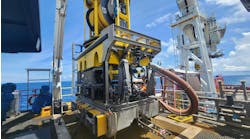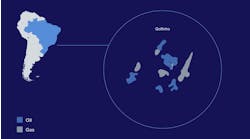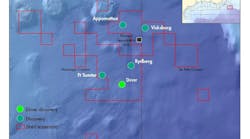Geologists from the Russian Institute for Oil Exploration and Research have determined that the Central American country of Honduras has commercial oil deposits of about 30 billion bbl off its Caribbean Mosquito Coast - a claim the locals are treating with cautious skepticism.
Former Director General of Mines and Hydrocarbons at the Honduran Ministry of Natural Resources says the claims are confusing Hondurans. He said previous studies have only indicated only 500,000 bbl of reserves, an insignificant amount. In addition, the country does not have a very strong track record for prospectivity.
Thirty-two wells have been drilled by such majors as Shell, Mobil, Texaco, and Chevron since 1920. Only one has yielded non-commercial oil and heavy gas. However, if the reserves are indeed there as the Russians speculate, it is estimated that Honduras will need over $250 million in investment to get any exploration activity underway.
This doesn't come as necessarily good news for Honduras, which is one of the poorest countries in the region and was severely battered last year by Hurricane Mitch. However, the oil potential may attract investment and provide assistance in unexpected ways.
OKIOC oil could be five years away
The first offshore well has been spudded off Kazakhstan in the Caspian Sea, but operators aren't expecting any major production for at least five years. The international consortium known as Offshore Kazakhstan International Operating Company (OKIOC) began drilling in August on the Kashagan East structure with the converted Sunkar drilling barge rig.
Kashagan East has been touted as potentially one of the world's largest hydrocarbon deposits, possibly containing 14 billion bbl. But OKIOC, while remaining optimistic, is not getting its hopes up just yet. The group says it expects to drill several wells before being able to assess the actual size and potential of the reservoir, and plans to study the reservoir for two years before making a recommendation. In addition, they do not plan to test this initial well until early next year. This would push any expected production startup into the fall of 2004 or early 2005; that is, if they find hydrocarbons.
To prove they are serious in this quest, the group has just invested an additional $60 million into the project, on top of the original investment of $600 million. A portion of this investment has already been put to good use in the local port town of Atyrau in the form of health care and infrastructure. Around $40 million has already been spent and an additional $9.9 million is planned for this year.
This large investment comes at a time when industry is having doubts about the region. Two consortia have pulled out of neighboring Azerbaijan and one company threatened to pull out of OKIOC. Several months ago, BP Amoco attempted to sell off their stake in the project, but pulled back, saying they did not receive good offers and the decision to sell was based on the small size of the company's share (9.5%).
However, this perceived lack of faith has not wavered the group's hopes for success. "There is a probability of failure, but the prize will fully justify the investment," OKIOC officials said. "This represents just about the largest undrilled structure in the world and we would not have invested $600 million."
OKIOC has license to 10 northern Caspian offshore blocks covering about 6,000 sq km. Partners in the consortium include: Agip, British Gas, a BP Amoco-Statoil alliance, Mobil, Shell, and TotalFina.
Exxon frustrated with Russian laws
Exxon has decided to face hard facts: $15 billion is a little too much to pay for a drilling program in a high risk sector. The company announced that due to environmental questions over how to discard low-toxicity drilling waste, it has cancelled its $15 billion Sakhalin I drilling project off Russia's Sakhalin Island.
Exxon reportedly stated it would like to dispose of the waste in the same manner as in other parts of the world, such as the Gulf of Mexico and the North Sea, but the Russian State Ecological Committee would not approve the plans. Exxon contends Russian laws on the subject contradict one other.
There is some speculation that the problems extend further than environmental disposal, and the constant political shakeups have made the country less attractive than before. Although Russia is one of the top oil producers in the world, international companies have had extreme difficulty in obtaining a return on multi-million dollar investments. With Exxon signaling frustration, others may pull back also.
Exxon said the cancellation will result in a loss of hundreds of Russian jobs and support to the local economy. It also added that in regards to Russian regulation, much more remains to be done. The company does intend to sell the natural gas it has already discovered in the region and feasibility studies are underway on a pipeline to Japan. Exxon said it may also attempt to proceed with the program, but due to the harsh environment, it would not occur until next summer.
One other project in the region is still underway, Sakhalin II. This project began production in mid-summer and is operated by a group consisting of Shell and USX-Marathon.
Deepwater discoveries continue to climb
Offshore Magazine's September issue reported 25 deepwater discoveries made worldwide since January of this year. Since the time of that writing, that number has increased another two discoveries, increasing the count to 27. With the price of oil on a steady rebound, drilling is once again taking off, and operators in the deepwater are beginning to reap the benefits.
The year started slowly for the deepwater with one discovery in January, that number climbed to three discoveries from February through May, and again climbed to four in June and July. But August has exceeded all expectations with six deepwater discoveries - three in the Gulf of Mexico, two offshore Angola, and one off India.
The Gulf of Mexico is competing with West Africa as the hottest deepwater theater this year. Twelve discoveries have been made in the Gulf of Mexico thus far, while West Africa is
following behind with nine (six in Angola and three in Nigeria). These two regions are blowing away the competition. The closest other competitor is Indonesia with three.
This deepwater surge is expected to continue. Since most operators E&P budgets are based on $11/bbl oil, and current price are over $20/bbl, the excesses should provoke a dramatic re-grading of prospects and increased drilling during the fourth quarter. If the discovery rate remains on the current path, the industry could have over 50 deepwater discoveries by year-end.


